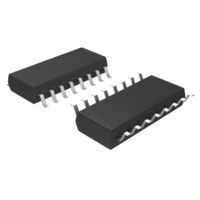MIC9131BM Micrel Inc, MIC9131BM Datasheet - Page 12

MIC9131BM
Manufacturer Part Number
MIC9131BM
Description
IC CTRLR DC-DC PWM HV HS 16-SOIC
Manufacturer
Micrel Inc
Datasheet
1.MIC9131YM.pdf
(19 pages)
Specifications of MIC9131BM
Applications
Controller, Telecom
Voltage - Input
9 ~ 18 V
Number Of Outputs
1
Voltage - Output
4.7 ~ 5 V
Operating Temperature
-40°C ~ 125°C
Mounting Type
Surface Mount
Package / Case
16-SOIC (3.9mm Width)
Lead Free Status / RoHS Status
Contains lead / RoHS non-compliant
Available stocks
Company
Part Number
Manufacturer
Quantity
Price
MIC9131
The timing capacitor, C
temperature stable film capacitor. Care must be taken when
using capacitor values less than 47pF. The high impedance of
a small value capacitor makes the OSC pin more susceptible
to switching noise. Also, the input capacitance of the OSC pin
and the stray capacitance of the board will have a noticeable
effect on the oscillator frequency.
Higher Switching Frequencies
The MIC9131 is capable of very high switching frequencies.
One of the limitations on the maximum frequency is the cur-
rent capability of the 5V regulator supplying the oscillator
and V
linear regulator much higher switching frequencies can be
achieved. A simple way of using an external current source
is to set an NPN as an emitter follower. Figure 5b shows the
MIC9131 oscillator frequency set to 4MHz using an external
NPN. The emitter followerj circuit allows the current to be
supplied by V
drop below V
temperature and voltage variations.
M9999-080206
C
R
OSC
OSC
BIAS
Where t
f
T
f
VBIAS
SYNC
S
S OUTPU
P_OSCILLATOR
OSC
_
_
. By powering V
OSCILLATOR
5
9
4
BIAS
CC
t
ON
DELAY
while the voltage is regulated to a diode
=
. This configuration is quite stable over
11
4
1
t
3V
PERIOD
AGND
=
×
= 75ns
=
OSC
t
f
T
S OSCILLATOR
CHARGE
Figure 5
P
_
BIAS
_
, should be an NPO ceramic or a
OSCILLATOR
1-shot
75ns
1
with an external source, e.g.
+
t
DISCHARGE
+
t
DELAY
V
Gate Drive
(pin 16)
OSC
12
Oscillator Synchronization
The switching frequency of the MIC9131 can be synchronized
to an external oscillator or frequency source. Figure 6 shows
the relationship between the sync input, oscillator waveform
and gate drive output. The external frequency should be set
at least 15% greater than the free running oscillator frequency
to account for tolerances in the oscillator circuit and external
components. The positive edge of the sync signal resets
the oscillator. The sync pulse frequency, like the oscillator,
is four times the gate drive frequency. When an external
sync signal is applied, the peak amplitude of the oscillator
signal (pin 4) is less than when it is free running because
the oscillator signal is terminated before it reaches its 3V
(typical) amplitude. When not used, the sync pin should
be connected to ground to prevent noise from erroneously
resetting the oscillator.
Soft Start Circuit
The soft start is programmed by a capacitor on the soft start
pin. A 4µA current source charges up the capacitor. At power
up, the SS pin is discharged. Once the UVLO and enable
functions release the soft start circuit, the voltage of the ca-
pacitor increases. The active voltage range of the soft start
pin is from typically from 0.9V to 1.7V. The internal current
source increases the voltage on the soft start capacitor to
approximately 4V. The soft start pin and the current sense
voltage are connected to a comparator in the MIC9131. The
voltage from the soft start pin effectively limits the peak current
through the current sense resistor by prematurely terminating
the on-time of the gate drive output. Referring to Figure 1,
with the soft start voltage low, the duty cycle of the output is
at a minimum. As the soft start voltage increases, the duty
4.7µF
2N3904
R
1.6k
C
33pF
OSC
1µF
OSC
Figure 6. Sync Waveform
4.7µF
VBIAS
AGND
SYNC
OSC
VCC
Figure 5a
2
5
9
4
11
TIME (500ns/div)
3V
1-shot
75ns
August 2006
Micrel, Inc.











